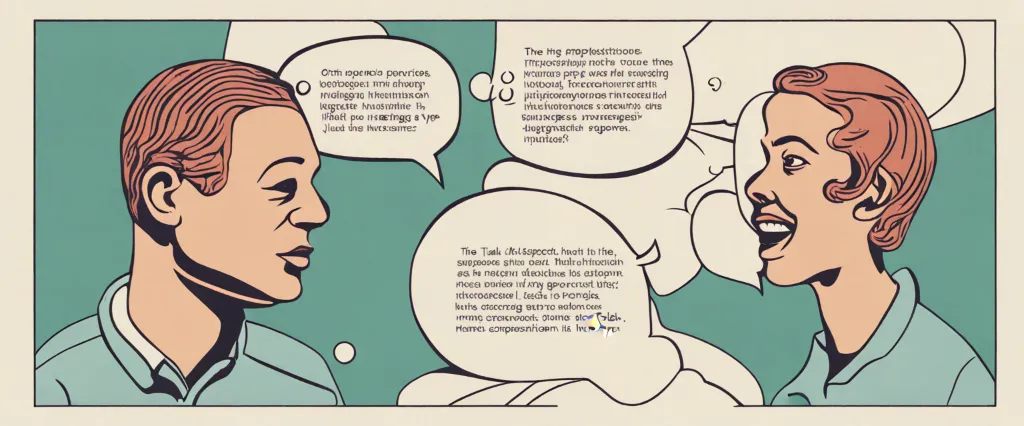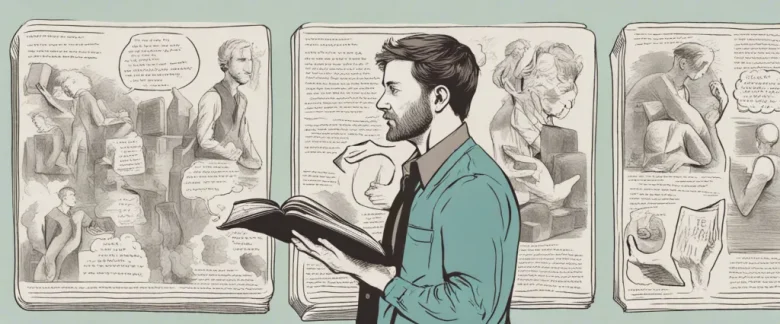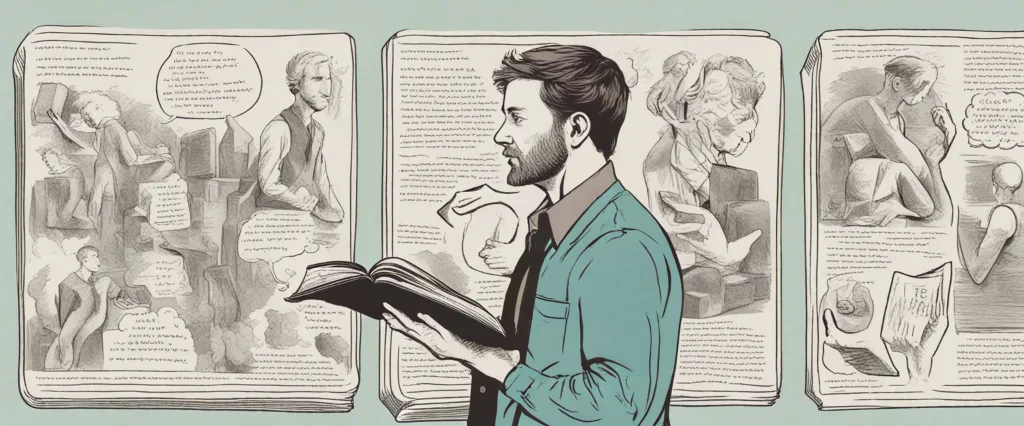In “The Definitive Book of Body Language,” renowned author Allan Pease unravels the intricate world of nonverbal communication, offering readers a fascinating insight into this powerful and often overlooked aspect of human interaction. Throughout his illustrious career, Pease has become a leading expert in body language, known for his ability to decipher the unspoken language that governs our everyday interactions. With his unique expertise, Pease delivers a comprehensive and engaging guide that empowers readers to both understand and utilize the subtle cues that shape our understanding of others and our own perceived intentions. With practical examples, insightful explanations, and a wealth of research, “The Definitive Book of Body Language” equips readers with the knowledge and skills to navigate the intricacies of human communication like never before.
Chapter 1: The Language of Gestures: Understanding the significance of hand movements, facial expressions, and body postures in communication.
Chapter 1 of “The Definitive Book of Body Language” by Allan Pease, titled “The Language of Gestures: Understanding the significance of hand movements, facial expressions, and body postures in communication,” explores the importance of nonverbal communication in our daily interactions. The chapter begins by stating that gestures, expressions, and postures are universal languages that can convey emotions and intentions across different cultures.
Pease emphasizes that understanding body language is vital, as it often reveals more about a person’s true feelings than their words. He explains that while verbal communication can be controlled and masked, body language tends to be more spontaneous and honest. The chapter provides several examples of how cultural differences can affect the interpretation of gestures, highlighting the importance of considering context and individual traits when analyzing body language.
Furthermore, the chapter delves into the significance of hand movements in communication. Pease explains that hands are an important tool for conveying messages, with gestures such as waving, pointing, and clenched fists carrying different meanings. The author also explores facial expressions and their role in conveying emotions like happiness, anger, or sadness, emphasizing the importance of paying attention to micro-expressions, which can reveal true feelings even when a person is consciously trying to hide them.
Finally, Pease discusses body postures and their influence on communication. He explains that open and relaxed postures indicate approachability and confidence, while closed or defensive postures can indicate discomfort or defensiveness. The author advises readers to consider clusters of gestures, expressions, and postures together to gain a comprehensive understanding of a person’s true thoughts and emotions.
In summary, Chapter 1 of “The Definitive Book of Body Language” highlights the universal nature of nonverbal communication and the significance of gestures, facial expressions, and body postures in understanding the true meaning behind spoken words. Pease emphasizes the need to consider cultural differences, context, and individual traits when interpreting body language, urging readers to pay attention to the subtleties and clusters of nonverbal cues to gain a more accurate understanding of others’ thoughts and feelings.
Chapter 2: Reading Facial Expressions: Exploring the various emotions conveyed through facial cues and microexpressions.
Chapter 2 of “The Definitive Book of Body Language” by Allan Pease explores the intricacies of reading facial expressions and the emotions conveyed through them, including microexpressions. It emphasizes the importance of understanding these cues as an essential aspect of nonverbal communication.
Pease begins by discussing the six universal facial expressions: anger, happiness, sadness, fear, surprise, and disgust. He delves into each emotion, describing the key facial cues associated with them. For instance, anger is characterized by narrowed eyes, raised eyebrows, and pursed lips, while happiness is often expressed through a wide smile and creases around the eyes.
Furthermore, the chapter explores the concept of microexpressions, which are brief and involuntary facial expressions that reveal genuine emotions. Pease highlights the significance of being able to detect these momentary flashes of instinctive emotions as they can provide valuable insights into a person’s true feelings or intentions. Microexpressions often occur within a fraction of a second, making them challenging to notice without keen observation and practice.
To help readers understand and interpret facial expressions accurately, Pease provides practical advice and exercises. He advises paying attention to the entire face, including the eyes, mouth, eyebrows, and forehead, as each part contributes to the overall expression. Additionally, he encourages readers to be aware of their own facial expressions and how they may influence others’ perceptions.
In summary, Chapter 2 of “The Definitive Book of Body Language” focuses on the importance of facial expressions and microexpressions in nonverbal communication. By exploring the six universal emotions and teaching readers how to recognize and interpret facial cues, Pease equips readers with a valuable skill to decode hidden emotions and enhance their understanding of others.
Chapter 3: Decoding Body Postures: Analyzing the meaning behind different body positions and stances.
Chapter 3 of “The Definitive Book of Body Language” by Allan Pease focuses on the decoding of body postures and analyzing the meanings conveyed by various body positions and stances.
Pease begins by emphasizing the significance of understanding body language, as it plays a vital role in our daily interactions. He explains that body postures are often subconscious and provide insight into a person’s emotions, attitudes, and intentions.
The chapter delves into specific body positions and their interpretations. For instance, the crossed-leg posture is commonly perceived as a defensive or closed-off stance, indicating discomfort, disagreement, or defensiveness. On the other hand, an open-leg posture suggests confidence, dominance, and readiness to engage.
Pease also explores the significance of arm positions. Folded arms usually imply defensiveness or disagreement, while open arms signal openness, inclusiveness, and a welcoming attitude. These interpretations can vary based on cultural contexts, but the general principles remain consistent.
The author further discusses the significance of head positions. Tilting the head slightly to one side during conversation signifies interest, attentiveness, and empathy. Conversely, a straight head alignment may indicate indifference or disinterest.
Pease also highlights the importance of analyzing clusters of body movements rather than individual gestures. Combining multiple signals, such as crossed arms, a tilted head, and closed-off leg positions, can help decode a person’s true intentions or emotions.
Overall, Chapter 3 elucidates the importance of decoding body postures and offers insights into the meanings conveyed by different body positions and stances. By understanding these nonverbal cues, individuals can enhance their communication skills, better assess others’ intentions, and improve their overall understanding of human behavior.
Chapter 4: Nonverbal Communication in Relationships: Examining how body language influences interactions and relationships.

Chapter 4 of “The Definitive Book of Body Language” by Allan Pease explores the topic of nonverbal communication in relationships, specifically focusing on how body language influences interactions and relationships.
The chapter begins by emphasizing the importance of nonverbal cues in human communication, stating that research has found that approximately 70% to 90% of communication is nonverbal. Despite this, many people tend to place more emphasis on words rather than paying attention to the nonverbal signals they are sending and receiving.
Pease discusses how body language plays a significant role in building rapport and forming connections between individuals. For instance, he explores various aspects of nonverbal communication, such as facial expressions, eye contact, gestures, and body posture. Understanding these cues is essential as they can convey emotions, attitudes, and intentions accurately.
Furthermore, the chapter delves into the impact of body language on relationship dynamics, covering topics such as flirting, power dynamics, and attraction. Pease explains that certain nonverbal signals can signal interest and attraction, and being aware of these cues can help individuals in developing and nurturing romantic relationships. Additionally, he addresses the influence of body language in determining power dynamics within relationships, such as through dominant or submissive gestures.
The chapter also sheds light on the challenges that can arise when different cultural backgrounds are involved. Pease highlights how cultural norms and beliefs shape body language and expressions, underscoring the need to be mindful and respectful of cultural differences.
In conclusion, Chapter 4 highlights the significance of nonverbal communication in relationships and how understanding and using body language effectively can greatly enhance interactions. Being attuned to nonverbal cues can help individuals form stronger connections, convey emotions accurately, and navigate various relationship dynamics more effectively.
Chapter 5: Detecting Deception: Uncovering the subtle signs of dishonesty and deceit through body language.
Chapter 5 of “The Definitive Book of Body Language” by Allan Pease focuses on detecting deception through body language. The chapter explores the subtle signs that indicate dishonesty and deceit, emphasizing the significance of nonverbal cues in understanding the truth behind someone’s words.
Pease begins by explaining that a person’s body language often contradicts their verbal statements when they are being deceptive. He highlights the importance of observing micro-expressions, which are fleeting facial expressions that reveal one’s true emotions. These micro-expressions can provide crucial insights into deception, as they are generally involuntary and uncontrollable.
The author then delves into specific body language cues that indicate dishonesty. For instance, liars may display signs of physical discomfort, such as fidgeting, touching their face, or avoiding eye contact. They may also unconsciously create barriers between themselves and others, such as crossed arms or legs, as a way to psychologically shield themselves from their lies.
Furthermore, Pease emphasizes the significance of baseline behavior – understanding how someone typically behaves in normal circumstances – to differentiate deceptive behavior from their usual patterns. Any significant deviation from their baseline behavior might suggest dishonesty.
The chapter also discusses vocal cues that indicate deception. For example, a liar might speak in an unusually high or low voice, use more hesitations, or have inconsistencies in their tone and pitch. Paying attention to these vocal cues can help uncover deception that may not be as apparent through body language alone.
In summary, Chapter 5 explores the various subtle signs of deception through body language and vocal cues. By closely observing and analyzing micro-expressions, discomfort gestures, and changes in vocal patterns, one can enhance their ability to detect dishonesty and deceit in others. Understanding these nonverbal cues provides essential insights into the underlying truth behind people’s words.
Chapter 6: Power and Influence: Exploring how body language can convey authority, dominance, and persuasive abilities.
Chapter 6 of “The Definitive Book of Body Language” by Allan Pease focuses on the concept of power and influence, specifically exploring how body language can convey authority, dominance, and persuasive abilities.
Pease begins the chapter by explaining that power and authority are often nonverbal, conveyed through various gestures and postures. He highlights certain cues that indicate dominance, such as occupying more space, keeping a more expansive posture, and using strong, decisive movements. These nonverbal cues, he argues, can create a sense of power and command respect from others.
The author then delves into specific body language signals that suggest authority and persuasion. He discusses the importance of eye contact, stating that maintaining direct eye contact is crucial in conveying confidence and authority. Additionally, Pease explains the significance of facial expressions in influencing others, noting that a relaxed, composed face can project a high level of self-assurance.
Furthermore, the chapter explores how body language can be used persuasively. Pease emphasizes that using open and friendly gestures, such as leaning in and nodding, can make others feel more receptive and open to persuasion. He also highlights the significance of mirroring the body language of the person one wishes to influence, as it creates a sense of rapport and connection.
In conclusion, Chapter 6 of “The Definitive Book of Body Language” delves into the role of body language in conveying power, authority, and persuasive abilities. By understanding and utilizing nonverbal cues effectively, individuals can project confidence, dominance, and successfully influence others.
Chapter 7: Cultural Variations: Understanding how cultural backgrounds can shape and influence nonverbal communication.
Chapter 7 of “The Definitive Book of Body Language” by Allan Pease delves into the topic of cultural variations and how different cultural backgrounds can shape and influence nonverbal communication.
Pease begins by emphasizing the importance of understanding cultural differences in nonverbal communication, as misinterpretation can lead to misunderstandings and conflicts. He stresses the need to respect and adapt to the cultural norms of others when communicating across cultures.
The chapter explores various aspects of cultural variations, including but not limited to personal space, eye contact, facial expressions, hand gestures, and touching. Pease highlights the stark differences between individualistic cultures, such as those in North America and Europe, and collectivistic cultures found in Asia, Africa, and the Middle East.
In individualistic cultures, personal space is valued and individuals tend to maintain larger distances between each other during interactions. Eye contact is seen as a sign of attentiveness and honesty. In contrast, collectivistic cultures prioritize group harmony and individuals tend to stand closer to each other, maintaining more extensive physical contact. Eye contact may be considered disrespectful or confrontational in such cultures.
Pease also discusses how facial expressions can differ across cultures. For instance, certain expressions that are associated with happiness, surprise, or anger may vary in intensity or meaning. Even hand gestures, which can convey different messages depending on the culture, require careful consideration.
To navigate the complexities of cultural variations, Pease advises individuals to engage in cross-cultural training and research to foster better understanding and empathy. He also cautions against assuming universal nonverbal cues and encourages active listening and observation to decipher the meaning behind nonverbal communication in diverse cultural contexts.
In conclusion, Chapter 7 presents a comprehensive overview of how cultural backgrounds shape and influence nonverbal communication. It serves as a reminder of the significance of cultural awareness in effective intercultural communication, urging individuals to adapt their nonverbal communication styles to accommodate different cultural norms.

Chapter 8: Enhancing Your Own Body Language: Techniques and tips for improving your own nonverbal communication skills.
Chapter 8 of “The Definitive Book of Body Language” by Allan Pease focuses on improving personal nonverbal communication skills by enhancing one’s own body language. The chapter provides various techniques and tips to help readers understand and utilize nonverbal cues effectively.
Pease begins by emphasizing the importance of congruence, where one’s body language is in alignment with their verbal message. He suggests that genuine and sincere body language is crucial for successful communication. To achieve this, Pease advises being aware of one’s body posture, facial expressions, and gestures, as they all convey messages to others.
Pease then explores specific methods to enhance body language. One technique is to adopt an open posture by standing or sitting with an open stance and avoiding crossing arms or legs, which can signal defensiveness or resistance. Another tip is to maintain appropriate eye contact, signaling attentiveness and interest in the conversation.
Furthermore, the chapter delves into the significance of facial expressions and gestures. Pease highlights the importance of genuine smiles, as fake smiles can be easily detected due to the absence of eye involvement. He suggests practicing smiling with the eyes to convey sincerity.
Additionally, Pease offers insights into the power of hand movements and how different gestures can influence the message being conveyed. For instance, open palm gestures are seen as trustworthy, while closed or hidden palm gestures may indicate deceit.
Overall, Chapter 8 of “The Definitive Book of Body Language” provides readers with practical techniques for enhancing one’s nonverbal communication skills. Pease emphasizes the importance of aligning body language with verbal messages and offers valuable tips regarding posture, facial expressions, eye contact, and hand gestures. By implementing these techniques and remaining conscious of their body language, readers can effectively improve their nonverbal communication skills.
After Reading
In conclusion, “The Definitive Book of Body Language” by Allan Pease serves as an extensive guide and resource on the intricacies of nonverbal communication. Through detailed explanations and real-life examples, Pease illustrates how body language can reveal a person’s true thoughts, feelings, and intentions. The book highlights the importance of understanding and decoding various gestures, postures, facial expressions, and other nonverbal cues in both personal and professional interactions. This comprehensive study sheds light on the powerful impact of nonverbal communication, equipping readers with valuable insights and practical tools to enhance their own body language skills. Overall, Pease’s work is an invaluable resource for anyone interested in mastering the art of nonverbal communication and harnessing its potential in various aspects of life.
1. Influence: The Psychology of Persuasion” by Robert Cialdini – This book explores the tactics and techniques used to influence others, examining the psychology behind them. It provides practical insights into the power of persuasion and how to navigate social situations effectively.
2. “What Every Body Is Saying” by Joe Navarro – Written by a former FBI counterintelligence officer, this book delves into the nonverbal cues and body language that people use to communicate. Navarro provides helpful tips on how to read and interpret these signals accurately.
3. The Charisma Myth: How Anyone Can Master the Art and Science of Personal Magnetism” by Olivia Fox Cabane – This book delves into the concept of charisma and teaches readers how to develop and enhance their own personal magnetism. It offers practical exercises and strategies for improving nonverbal communication skills.
4. Talking to Strangers: What We Should Know About the People We Don’t Know” by Malcolm Gladwell – In this thought-provoking book, Gladwell explores the complexities of human interactions and highlights the challenges of accurately interpreting others’ behaviors. It covers topics like deception, trust, and miscommunication, shedding light on the lessons we can learn from these encounters.
5. “You Can Read Anyone: Never Be Fooled, Lied To, or Taken Advantage Of Again” by David J. Lieberman – This book emphasizes the importance of understanding human behavior and being able to accurately interpret others’ intentions. It provides valuable insights into reading others’ body language and identifying underlying motivations and hidden agendas.




